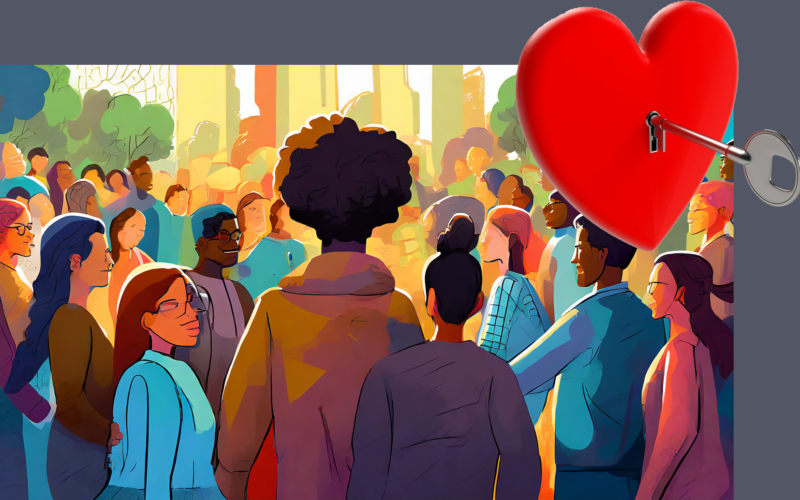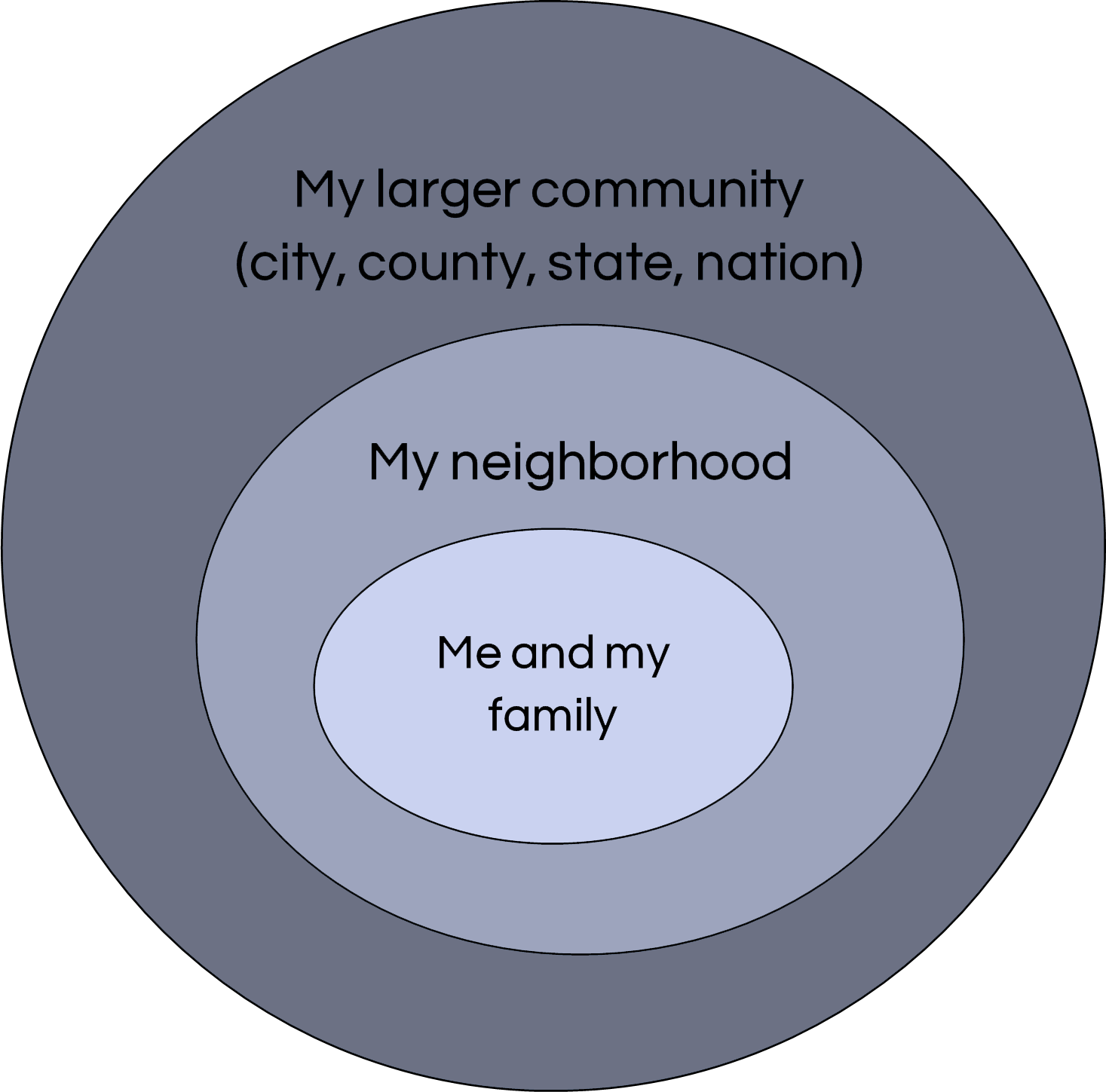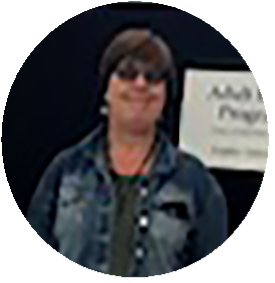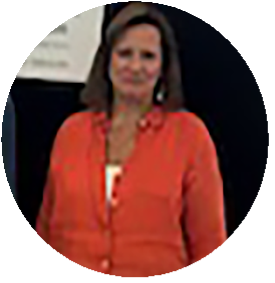Community as a Key to Unlocking Civics Education

by Susan Otero and MaryAnn Cunningham Florez
“What really matters from the point of view of social capital and civic engagement is not merely nominal membership, but active and involved membership”. — Robert D. Putnam
The community/civics education connection
What motivates people to be civically in building and maintaining it? In a learning participatory? Is it when they community like our adult English for Speakers recognize the benefits of living within of Other Languages (ESOL) program, we know a community and what it can provide them? Is it that supporting students in feeling a sense of when they understand their own roles and their belonging, interdependence, relevance, and self-value in a community so that they become invested efficacy—community—promotes engagement and achievement. Why not capitalize on that relatable concept of community and help students expand outward, linking their learning with their real communities? For example, when considering instruction, community could start with field trips to community concerts or farmers’ markets but can then lead to practicing higher levels of civic participation such as providing input at meetings on park revitalization initiatives, volunteering to support homebound senior citizens, or doing outreach on topics of interest to immigrant communities.
Why we chose to focus on community
Thinking of community as a key component of civic participation helped our program develop community as a central topic around which we could build instruction for our annual summer term. The term is very brief (4–5 weeks) and requires a focus that keeps continuing learners connected while providing a welcoming space for new learners who are walking into our program for the first time. We also wanted the instruction to be engaging, rigorous, and flexible enough to serve students at different language proficiency levels and varied experiences of participation in their U.S. communities. As those objectives could involve everything from helping students build vocabulary about their communities to accessing community resources or identifying community issues, we challenged ourselves to begin building out a curriculum that would support students in language, skills, and awareness to support civic participation. Fortunately, using community as a gateway to civic instruction also easily accommodated best strategies and practices from adult English language instruction, adult learning, employability skills development, and academic language and skills development.
*See the box for references of some of the important resources we consulted as we developed (and continue to develop) our civic participation instruction through the context of community.
• Adult Learning Theories
https://lincs.ed.gov/sites/default/ fles/11_%20TEAL_Adult_Learning_Theory.pdf
• Adult Learner Persistence: Drivers of Persistence
https://nelrc.org/persist/drivers.html
• Center for Applied Linguistics 8 Fundamental Principles of Effective Adult English Language Instruction
https://www.cal.org/cals-8-fundamen¬tal-principles-of-efective-adult-english-language-instruction/
• Employability Skills Framework
https://lincs.ed.gov/state-resources/ federal-initiatives/employability-skills-framework
• Teaching Skills That Matter and the TSTM Civics Education brief
https://lincs.ed.gov/state-resources/ federal-initiatives/teaching-skills-matter-adult-education
https://lincs.ed.gov/sites/default/fles/TST¬MCivEducationBrief-508.pdf
The Levels
 Our program offers classes at six levels (low/ high beginning, intermediate and advanced). In the summer session, some classes are combination classes, so we looked for materials that are flexible and relevant across the levels. Here’s how we addressed the common theme of community at different levels.
Our program offers classes at six levels (low/ high beginning, intermediate and advanced). In the summer session, some classes are combination classes, so we looked for materials that are flexible and relevant across the levels. Here’s how we addressed the common theme of community at different levels.
Beginning-level learners used the Oxford Picture Dictionary as they were supported in building vocabulary and English language proficiency in the context of exploring the community. From a focus on “me and my place in the community”, students learned about and connected with resources the local community has to offer.
Intermediate-level students read articles from The Change Agent, a digital adult education magazine written by fellow learners. While increasing English language development, they explored self-identification and their role in the community, connected with resources, identified issues/problems (both personal and collective) and brainstormed action steps, discovered growth opportunities in new communities, and collaborated on ideas of how to welcome others new to the community.
Advanced-level classes bridged from social communication to more rigorous academic content. The young adult novel Seedfolks, about a diverse group of people who turn a vacant lot into a thriving community garden, provided a rich context to explore what it means to be part of a community and how the actions of each individual can positively impact an entire community. There were also ample opportunities to engage with academic and higher-level language functions, reading strategies, and use of digital skills and tools.
Curricular and support materials
The program invested and will continue investing in program-specific resources to organize and share materials with instructors across multiple locations and class times. The program utilized shared Google drives for each curriculum to provide lesson plan templates, a pacing guide or outline of topics over the course for both intensive and non-intensive class schedules, and sample lessons. We shared curated Oxford Picture Dictionary supplemental materials related to community. We recommended articles in The Change Agent, issue 57-Creating New Community. Further, Seedfolks has been in a 10-year process of developing resources, cultivating teacher development, and sharing supplemental materials. They provide digital literacy-enhanced elements such as a student blog, student created Google slides, etc.
Using a shared Google drive allows for promoting the collective development and/or sharing of teacher-developed materials, thus creating an ongoing community for the teachers around the curriculum. Additionally, we conducted level-specific introductory training for teachers prior to the launch of classes.
Primary Curricular Materials
• Low and High-Beginning Levels
Adelson-Goldstein, J. & Shapiro, N. (2016). Oxford Picture Dictionary (2nd ed.). Oxford University Press. https://elt.oup.com/ catalogue/items/global/dictionaries/ oxford_picture_dictionary_third_edi¬tion/9780194505291?cc=us&selLan¬guage=en
The accompanying eBook and OPD Teacher Resource Center (both require paid accounts) are critical resources for the instructors.
• Low and High-Intermediate Levels
Peters, C. (Ed.). (2022, November). Creating New Community: The Change Agent. The New England Literacy Resource Center/World Education. https://changeagent.nelrc. org/wp-content/uploads/2022/12/ Issue-57-Creating-New-Commu¬nity-2.pdf
* Login username: VALRC, PW: VALRC2023
• Low and High-Advanced Levels
Fleischman, P. (1997). Seedfolks. HarperCollins Publishers. https:// www.harpercollins.com/products/ seedfolks-paul-feischman?vari ant=41225498525730
 Susan Otero is the Educational Specialist and MaryAnn Cunningham Florez is the Program Manager for Fairfax County Public Schools (FCPS) Adult ESOL Program. Together they have 60+ years working in all aspects of
Susan Otero is the Educational Specialist and MaryAnn Cunningham Florez is the Program Manager for Fairfax County Public Schools (FCPS) Adult ESOL Program. Together they have 60+ years working in all aspects of  adult ESOL education in the Northern Virginia area and abroad.
adult ESOL education in the Northern Virginia area and abroad.
* Please note: Access to “The Change Agent” changes with each calendar year (e.g., username: valrc, pw: VALRC2024)
